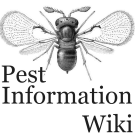Publications for:
pest = Adoxophyes honmai
crop = Tea (Camellia sinensis)
found 17 publications:2022
Development of allele-specific loop-mediated isothermal amplification (AS-LAMP) to detect the tebufenozide-resistant allele in the smaller tea tortrix, Adoxophyes honmai (Lepidoptera: Tortricidae)Applied Entomology and Zoology (2022) 57 (1), 93-99
publishers website - pestinfo wiki
2021
Effect of leaf maturity on host habitat location by the egg-larval parasitoid Ascogaster reticulataJournal of Chemical Ecology (2021) 47 (3), 294-302
publishers website - pestinfo wiki
2019
Tebufenozide resistance in the smaller tea tortrix, Adoxophyes honmai (Lepidoptera: Tortricidae): establishment of a molecular diagnostic method based on EcR mutation and its application for field-monitoringApplied Entomology and Zoology (2019) 54 (2), 223-230
publishers website - pestinfo wiki
Species-specific elicitors induce tea leaf to arrest the endoparasitoid Ascogaster reticulata (Hymenoptera: Braconidae)
Journal of Applied Entomology (2019) 143 (1-2), 43-48
publishers website - pestinfo wiki
2018
Color preference and associative color learning in a parasitoid wasp, Ascogaster reticulata (Hymenoptera: Braconidae)Journal of Insect Behavior (2018) 31 (5), 523-534
publishers website - pestinfo wiki
2016
Sex-specific elicitor from Adoxophyes honmai (Lepidoptera: Tortricidae) induces tea leaf to arrest the egg–larval parasitoid Ascogaster reticulata (Hymenoptera: Braconidae)Applied Entomology and Zoology (2016) 51 (3), 353-362
publishers website - pestinfo wiki
Oviposition preference for leaf age in the smaller tea tortrix Adoxophyes honmai (Lepidoptera: Tortricidae) as related to performance of neonates
Applied Entomology and Zoology (2016) 51 (3), 363-371
publishers website - pestinfo wiki
2015
Field efficacy and transmission of fast- and slow-killing nucleopolyhedroviruses that are infectious to Adoxophyes honmai (Lepidoptera: Tortricidae)Viruses (2015) 7 (3), 1271-1283
publishers website - pestinfo wiki
2014
Rapid development of resistance to diamide insecticides in the smaller tea tortrix, Adoxophyes honmai (Lepidoptera: Tortricidae), in the tea fields of Shizuoka Prefecture, JapanApplied Entomology and Zoology (2014) 49 (4), 529-534
publishers website - pestinfo wiki
Chemo-orientation responses in hymenopteran parasitoids induced by substrate-borne semiochemicals
BioControl (2014) 59 (1), 1-17
publishers website - pestinfo wiki
2013
[Susceptibility and resistance to diacylhydrazine analog insect growth regulator insecticides in the smaller tea tortrix, Adoxophyes honmai Yasuda (Lepidoptera: Tortricidae), collected in tea fields in Shizuoka Prefecture, Japan]Japanese Journal of Applied Entomology and Zoology (2013) 57 (2), 85-93
publishers website - pestinfo wiki
2012
Herbivore egg deposition induces tea leaves to arrest the egg-larval parasitoid Ascogaster reticulataEntomologia Experimentalis et Applicata (2012) 144 (2), 172-180
publishers website - pestinfo wiki
2009
Insect pests of tea and their managementAnnual Review of Entomology (2009) 54, 267-284
publishers website - pestinfo wiki
2007
Sex pheromone production and perception in the mating disruption-resistant strain of the smaller tea leafroller moth, Adoxophyes honmaiEntomologia Experimentalis et Applicata (2007) 122 (2), 145-153
publishers website - pestinfo wiki
2005
Effects of temperature and photoperiod on the development and reproduction of Adoxophyes honmai (Lepidoptera: Tortricidae)Applied Entomology and Zoology (2005) 40 (2), 231-238
publishers website - pestinfo wiki
2002
Resistance to a mating disruptant composed of (Z)-11-tetradecenyl acetate in the smaller tea tortrix, Adoxophyes honmai (Yasuda) (Lepidoptera: Tortricidae)Applied Entomology and Zoology (2002) 37 (2), 299-304
publishers website - pestinfo wiki
1997
Seasonal changes in prevalence of viral disease and parasitism by parasitic insects in a larval population of the smaller tea tortrix, Adoxophyes sp. (Lepidoptera: Tortricidae) in a tea fieldApplied Entomology and Zoology (1997) 32 (4), 609-615
pestinfo wiki
